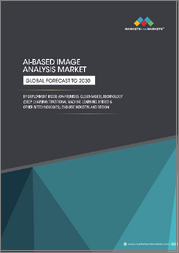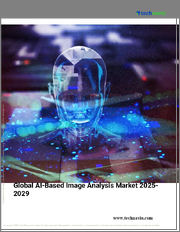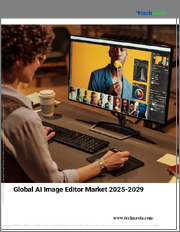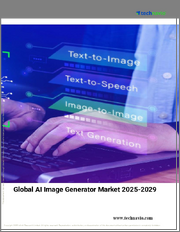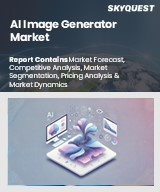
|
시장보고서
상품코드
1850265
AI 이미지 인식 : 시장 점유율 분석, 산업 동향, 통계, 성장 예측(2025-2030년)AI Image Recognition - Market Share Analysis, Industry Trends & Statistics, Growth Forecasts (2025 - 2030) |
||||||
AI 이미지 인식 시장 규모는 2025년에 49억 7,000만 달러로 추정되고, 2030년에는 CAGR 14.52%로 성장할 전망이며, 97억 9,000만 달러에 이를 것으로 예측됩니다.

이 확장은 공장 현장에서 진단실에 이르는 자동 시각 지능에 대한 기업의 의존에 뿌리를 두고 있습니다. 실리콘 비용 저하, 멀티 모달 기반 모델 및 성숙한 에지 하드웨어로 총 소유 비용이 감소하는 경향이 있으며 대규모 전개가 경제적으로 실행 가능합니다. 공급업체는 칩, 소프트웨어 및 서비스를 번들로 제공하는 수직 통합 스택에 자본을 돌리며 조달 사이클을 간소화하고 전개 속도를 높이고 있습니다. 한편, 합성 데이터 엔진은 라벨링 예산을 줄이고, 지금까지 주석이 달린 이미지가 없었던 중견기업에도 진입의 폭을 넓히고 있습니다. 이러한 동향을 종합하면 AI 이미지 인식 시장은 2자리 성장을 지속할 것으로 보입니다.
세계의 AI 이미지 인식 시장 동향 및 인사이트
클라우드 네이티브 AI 채용 붐
하이퍼스케일 제공업체는 컨테이너화된 비전 파이프라인을 제공하여 모델을 프로토타입에서 생산까지 몇 주 이내에 푸시하여 제조업체 및 소매업체의 Time-to-Value를 단축합니다. Microsoft Azure와 Google Cloud는 패키징된 결함 감지 청사진을 도입하고 ML 직원이 제한된 기업의 진입 장벽을 낮추고 있습니다. Kubernetes로 오케스트레이션된 추론 엔드포인트는 이미지가 도착할 때만 계산을 할당하여 고정 온프레미스 클러스터에 비해 15-40%의 비용 절감을 가능하게 합니다. 그 결과, AI 이미지 인식 시장은 보다 신속한 조달 사이클과 광범위한 사용자 다양성으로부터 혜택을 누릴 수 있습니다.
고해상도 카메라의 보급
5세대 자동차용 ADAS 유닛과 8K 산업용 센서는 현재 네트워크 라운드 트립 없이 50밀리초 이하의 추론을 실현하는 온 디바이스 AI 가속기와 쌍을 이루고 있습니다. 콘티넨탈 MFC525 카메라는 110도 시야를 제공하면서 로컬로 물체 분류를 수행하고 삼성의 최신 신경 엔진은 소비자 스마트폰 내에서 38TOPS를 달성하고 있습니다. 이러한 기능은 실시간 품질 관리 및 몰입형 AR 기능을 해제하고 AI 이미지 인식 시장의 저변을 확장합니다.
데이터 프라이버시 및 컴플라이언스 장애물
EU의 인공지능법과 캘리포니아 주법은 견고한 감사 추적을 부과하고 있으며, 의료용 이미지 전개 시 검증 비용이 최대 30%까지 증가합니다. 상충되는 데이터 거주 의무는 듀얼 스택 아키텍처를 강요하고 개인 정보 보호 전문 팀이 없는 중간 규모 병원에서의 도입을 지연시킵니다. 이러한 마찰은 AI 이미지 인식 시장의 성장세를 약화시키고 있습니다.
부문 분석
하드웨어는 2024년 매출의 45.6%를 차지했는데, 서비스의 CAGR은 14.9%로 다른 모든 카테고리를 상회합니다. NVIDIA와 Intel의 엣지 대응 카메라와 추론 칩은 대기 시간을 50ms 이하로 낮추어 제조 공장의 브라운필드 리노베이션에 활력을 줍니다. 소프트웨어, 특히 저 코드 모델 운영 플랫폼은 깊은 데이터 사이언스 벤치가 없는 기업의 맞춤형 파이프라인 작성을 용이하게 합니다. 반면에 전문 서비스 제공업체는 도메인 튜닝된 데이터 세트와 지속적인 학습 워크플로우를 구축하여 첫 번째 입증 포인트를 넘어 생산 정확도를 향상시킵니다. 이와 같이 개별 제품이 아닌 전체적인 성과로 이동함으로써 AI 이미지 인식 시장에서 통합자의 지갑 점유율이 확대되고 있습니다.
병원, 은행 및 방위 기관은 로컬 방화벽 내에 이미지를 보관해야 하기 때문에 온프레미스 시스템은 2024년 68.7%의 판매를 유지합니다. 광산, 선박, 원격지 공장과 같은 에지 시나리오에서는 간헐적인 연결성으로 인해 클라우드 라운드 트립이 불가능하기 때문에 이러한 선호도가 반영됩니다. 그럼에도 불구하고 탄력적인 GPU 풀이 계절적 또는 버스트 적으로 많은 양의 이미지 파이프라인을 흡수하기 때문에 클라우드 워크로드는 CAGR 16.7%로 성장하고 있습니다. 하이브리드 토폴로지는 에지 전처리와 클라우드 재교육을 결합하여 기업이 페타스케일 데이터 세트를 집중적으로 활용하면서 엣지에서 추론을 조정할 수 있도록 합니다. 이 혼합 패러다임은 컴플라이언스를 지키면서 하이퍼스케일러의 경제성에서 혜택을 누리고 AI 이미지 인식 시장의 장기적인 확장을 뒷받침합니다.
지역 분석
북미는 2024년 매출의 27.8%를 차지했으며, TSMC의 1,650억 달러의 애리조나 캠퍼스와 같은 치밀한 자금 조달 생태계와 국내 칩 제조 이니셔티브에 의해 지원되고 있습니다. Meta의 Scale AI에 대한 148억 달러의 투자로 볼 수 있듯이 기업의 M&A는 이 지역의 연구개발 속도를 높이고 있습니다. 반도체의 회복력에 대한 정부의 우대조치가 미국과 캐나다의 AI 이미지 인식 시장을 더욱 지원하고 있습니다.
유럽은 이 지역의 엄격한 AI법에 의해 완만하지만 꾸준한 채용을 나타내고 있습니다. 독일의 중공업 리더는 자동 조립에 비전을 짜고 프랑스 신흥 기업은 GDPR(EU 개인정보보호규정)의 보호 조치 하에서 임상 판단 지원을 세련하고 있습니다. 투자는 규율을 유지하면서도 목표를 좁혀 투명성과 바이어스의 경감을 증명할 수 있는 벤더를 선호하고 있습니다. 이러한 엄격함은 AI 이미지 인식 시장 전체의 솔루션 설계를 형성하고 있습니다.
아시아태평양의 CAGR은 15.9%로 가장 높습니다. 중국은 스마트시티와 감시 그리드에 700억 달러를 넘는 다년도 예산을 할당하고 있습니다. 일본의 650억 달러 반도체 프로그램과 한국 HBM 메모리의 리더십은 수직 통합 공급 기반을 형성합니다. 인도 개발자 풀은 경쟁력 있는 가격으로 세계 모델 튜닝 서비스를 유지하고 AI 이미지 인식 시장을 총체적으로 가속화시킵니다.
기타 혜택 :
- 엑셀 형식 시장 예측(ME) 시트
- 3개월간의 애널리스트 서포트
목차
제1장 서론
- 조사의 전제조건 및 시장 정의
- 조사 범위
제2장 조사 방법
제3장 주요 요약
제4장 시장 상황
- 시장 개요
- 시장 성장 촉진요인
- 클라우드 네이티브 AI 도입의 붐
- 고해상도 카메라의 보급
- 소매업에 있어서 손실 방지 대처
- 스마트시티 및 모니터링 인프라 확대
- 합성 데이터 파이프라인이 라벨링 비용을 대폭 절감
- 위성 화상 회사가 라벨 첨부 세트를 오픈소스화
- 시장 성장 억제요인
- 데이터 프라이버시 및 컴플라이언스의 장애물
- 분야 특유의 인재 부족
- GPU 공급망의 지정학이 설비 투자 리스크 증가 초래
- 편향된 알고리즘에 의한 법적 위험 증가
- 공급망 분석
- 규제 상황
- 기술 전망(엣지 추론과 클라우드 추론)
- Porter's Five Forces
- 구매자의 협상력
- 공급기업의 협상력
- 신규 참가업체의 위협
- 대체품의 위협
- 경쟁도
- 거시경제 요인 평가
제5장 시장 규모 및 성장 예측
- 컴포넌트별
- 하드웨어
- 소프트웨어
- 서비스
- 전개 모델별
- 클라우드
- 온프레미스
- 용도별
- 이미지 분류
- 물체 검출 및 추적
- 얼굴 인식
- 산업 검사
- 의료 이미지
- 기타 틈새 용도
- 최종 사용자 업계별
- 자동차
- BFSI
- 의료 제공자 및 의료 기술
- 소매업 및 전자상거래
- 보안 및 모니터링 통합자
- 제조업
- 기타(농업, 에너지 등)
- 지역별
- 북미
- 미국
- 캐나다
- 멕시코
- 남미
- 브라질
- 아르헨티나
- 기타 남미
- 유럽
- 독일
- 영국
- 프랑스
- 이탈리아
- 스페인
- 기타 유럽
- 아시아태평양
- 중국
- 일본
- 인도
- 한국
- 호주
- 기타 아시아태평양
- 중동 및 아프리카
- 중동
- 사우디아라비아
- 아랍에미리트(UAE)
- 튀르키예
- 기타 중동
- 아프리카
- 남아프리카
- 나이지리아
- 이집트
- 기타 아프리카
- 북미
제6장 경쟁 구도
- 시장 집중도
- 전략적 동향
- 시장 점유율 분석
- 기업 프로파일
- Google(Alphabet)
- Clarifai
- IBM
- Intel
- Micron Technology
- Microsoft
- NVIDIA
- Qualcomm
- Samsung Electronics
- AMD/Xilinx
- Apple
- SenseTime
- Hikvision
- Megvii
- NEC Corporation
- Cognex
- Zebra Technologies
- Huawei Technologies
- Palantir
제7장 시장 기회 및 향후 전망
AJY 25.11.07The AI image recognition market size is estimated at USD 4.97 billion in 2025 and is forecast to reach USD 9.79 billion by 2030, reflecting a 14.52% CAGR.

This expansion is rooted in enterprise reliance on automated visual intelligence that now stretches from factory floors to diagnostic suites. Falling silicon costs, multimodal foundation models, and maturing edge hardware keep total cost of ownership on a downward trajectory, making large-scale rollouts economically viable. Vendors redirect capital toward vertically integrated stacks that bundle chips, software, and services, streamlining procurement cycles and boosting deployment velocity. Meanwhile, synthetic data engines shrink labeling budgets, broadening participation for mid-sized firms that previously lacked annotated imagery. Collectively, these trends position the AI image recognition market for durable double-digit growth.
Global AI Image Recognition Market Trends and Insights
Cloud-Native AI Adoption Boom
Hyperscale providers deliver containerized vision pipelines that push models from prototype to production inside weeks, trimming time-to-value for manufacturers and retailers. Microsoft Azure and Google Cloud showcase packaged defect-detection blueprints that lower entry barriers for firms with limited ML staff. Kubernetes-orchestrated inference endpoints allocate compute only when imagery arrives, enabling 15-40% cost savings versus fixed on-premise clusters. As a result, the AI image recognition market benefits from faster procurement cycles and broader user diversity.
Proliferation of High-Resolution Cameras
Fifth-generation automotive ADAS units and 8K industrial sensors now pair with on-device AI accelerators that deliver sub-50 ms inference without network round-trips. Continental's MFC525 camera offers a 110-degree field of view while performing object classification locally, and Samsung's latest neural engines hit 38 TOPS inside consumer smartphones. These capabilities unlock real-time quality control and immersive AR functions, widening the addressable base of the AI image recognition market.
Data-Privacy and Compliance Hurdles
The EU AI Act and California statutes impose robust audit trails, inflating validation costs by up to 30% for medical-imaging deployments. Conflicting data-residency mandates compel dual-stack architectures, slowing rollouts among mid-size hospitals that lack dedicated privacy teams. Such friction tempers growth momentum in the AI image recognition market.
Other drivers and restraints analyzed in the detailed report include:
- Retail Loss-Prevention Initiatives
- Synthetic Data Pipelines Slashing Labelling Cost
- GPU Supply Chain Geopolitics Elevating Capex Risk
For complete list of drivers and restraints, kindly check the Table Of Contents.
Segment Analysis
Hardware controlled 45.6% of 2024 revenue, yet services post a 14.9% CAGR that outpaces all other categories. Edge-ready cameras and inference chips from NVIDIA and Intel lower latency below 50 ms, energizing brownfield retrofits in manufacturing plants. Software, especially low-code model-ops platforms, eases custom pipeline creation for firms without deep data-science benches. Meanwhile, professional services providers craft domain-tuned datasets and continuous-learning workflows that elevate production accuracy beyond initial proof points. This shift toward holistic outcomes rather than discrete products broadens wallet share for integrators inside the AI image recognition market.
On-premises systems retained 68.7% revenue in 2024 because hospitals, banks, and defense agencies must keep imagery within local firewalls. Edge scenarios in mines, ships, and remote factories mirror this preference, where intermittent connectivity precludes cloud round-trips. Even so, cloud workloads grow at 16.7% CAGR as elastic GPU pools absorb seasonal or burst-heavy image pipelines. Hybrid topologies marry edge preprocessing with cloud retraining, letting enterprises tune inference at the edge while leveraging petascale datasets centrally. This blended paradigm safeguards compliance yet benefits from hyperscaler economics, reinforcing long-run expansion of the AI image recognition market.
AI Image Recognition Market Report is Segmented by Type (Hardware, Software, and Services), Deployment Model (Cloud, On-Premises), Application (Image Classification, Object Detection and Tracking, Facial Recognition, and More), End-User Industry (Automotive, BFSI, and More), and by Geography. The Market Forecasts are Provided in Terms of Value (USD).
Geography Analysis
North America held 27.8% revenue in 2024, buoyed by a dense funding ecosystem and domestic chip fabrication initiatives such as TSMC's USD 165 billion Arizona campus. Corporate M&A, evidenced by Meta's USD 14.8 billion stake in Scale AI, intensifies regional R&D velocity. Government incentives for semiconductor resilience further anchor the AI image recognition market in the United States and Canada.
Europe exhibits moderated yet steady adoption, framed by the bloc's stringent AI Act. German heavy-industry leaders weave vision into automated assembly, while French startups refine clinical decision support under GDPR safeguards. Investment remains disciplined but targeted, favoring vendors able to certify transparency and bias mitigation. Such rigor shapes solution design across the AI image recognition market.
Asia-Pacific shows the highest trajectory at 15.9% CAGR. China allocates multiyear budgets topping USD 70 billion for smart-city and surveillance grids. Japan's USD 65 billion semiconductor program and South Korea's leadership in HBM memory create a vertically integrated supply base. India's developer pool sustains global model-tuning services at competitive rates, collectively accelerating the AI image recognition market.
- Google (Alphabet)
- Clarifai
- IBM
- Intel
- Micron Technology
- Microsoft
- NVIDIA
- Qualcomm
- Samsung Electronics
- AMD/Xilinx
- Apple
- SenseTime
- Hikvision
- Megvii
- NEC Corporation
- Cognex
- Zebra Technologies
- Huawei Technologies
- Palantir
Additional Benefits:
- The market estimate (ME) sheet in Excel format
- 3 months of analyst support
TABLE OF CONTENTS
1 INTRODUCTION
- 1.1 Study Assumptions and Market Definition
- 1.2 Scope of the Study
2 RESEARCH METHODOLOGY
3 EXECUTIVE SUMMARY
4 MARKET LANDSCAPE
- 4.1 Market Overview
- 4.2 Market Drivers
- 4.2.1 Cloud-native AI adoption boom
- 4.2.2 Proliferation of high-resolution cameras
- 4.2.3 Retail loss-prevention initiatives
- 4.2.4 Expansion of Smart Cities and Surveillance Infrastructure
- 4.2.5 Synthetic data pipelines slashing labeling cost
- 4.2.6 Satellite imagery firms open-sourcing labeled sets
- 4.3 Market Restraints
- 4.3.1 Data-privacy and compliance hurdles
- 4.3.2 Shortage of domain-specific talent
- 4.3.3 GPU supply chain geopolitics elevating capex risk
- 4.3.4 Rising legal exposure from biased algorithms
- 4.4 Supply-Chain Analysis
- 4.5 Regulatory Landscape
- 4.6 Technological Outlook (Edge vs Cloud inference)
- 4.7 Porter's Five Forces
- 4.7.1 Bargaining Power of Buyers
- 4.7.2 Bargaining Power of Suppliers
- 4.7.3 Threat of New Entrants
- 4.7.4 Threat of Substitutes
- 4.7.5 Degree of Competition
- 4.8 Assessment of Macroeconomic Factors
5 MARKET SIZE AND GROWTH FORECASTS (VALUE)
- 5.1 By Component
- 5.1.1 Hardware
- 5.1.2 Software
- 5.1.3 Services
- 5.2 By Deployment Model
- 5.2.1 Cloud
- 5.2.2 On-premises
- 5.3 By Application
- 5.3.1 Image Classification
- 5.3.2 Object Detection and Tracking
- 5.3.3 Facial Recognition
- 5.3.4 Industrial Inspection
- 5.3.5 Medical Imaging
- 5.3.6 Other Niche Applications
- 5.4 By End-user Industry
- 5.4.1 Automotive
- 5.4.2 BFSI
- 5.4.3 Healthcare Providers and Med-tech
- 5.4.4 Retail and E-commerce
- 5.4.5 Security and Surveillance Integrators
- 5.4.6 Manufacturing
- 5.4.7 Others (Agriculture, Energy, etc.)
- 5.5 By Geography
- 5.5.1 North America
- 5.5.1.1 United States
- 5.5.1.2 Canada
- 5.5.1.3 Mexico
- 5.5.2 South America
- 5.5.2.1 Brazil
- 5.5.2.2 Argentina
- 5.5.2.3 Rest of South America
- 5.5.3 Europe
- 5.5.3.1 Germany
- 5.5.3.2 United Kingdom
- 5.5.3.3 France
- 5.5.3.4 Italy
- 5.5.3.5 Spain
- 5.5.3.6 Rest of Europe
- 5.5.4 Asia-Pacific
- 5.5.4.1 China
- 5.5.4.2 Japan
- 5.5.4.3 India
- 5.5.4.4 South Korea
- 5.5.4.5 Australia
- 5.5.4.6 Rest of Asia-Pacific
- 5.5.5 Middle East and Africa
- 5.5.5.1 Middle East
- 5.5.5.1.1 Saudi Arabia
- 5.5.5.1.2 United Arab Emirates
- 5.5.5.1.3 Turkey
- 5.5.5.1.4 Rest of Middle East
- 5.5.5.2 Africa
- 5.5.5.2.1 South Africa
- 5.5.5.2.2 Nigeria
- 5.5.5.2.3 Egypt
- 5.5.5.2.4 Rest of Africa
- 5.5.1 North America
6 COMPETITIVE LANDSCAPE
- 6.1 Market Concentration
- 6.2 Strategic Moves
- 6.3 Market Share Analysis
- 6.4 Company Profiles (includes Global level Overview, Market level overview, Core Segments, Financials as available, Strategic Information, Market Rank/Share for key companies, Products and Services, and Recent Developments)
- 6.4.1 Google (Alphabet)
- 6.4.2 Clarifai
- 6.4.3 IBM
- 6.4.4 Intel
- 6.4.5 Micron Technology
- 6.4.6 Microsoft
- 6.4.7 NVIDIA
- 6.4.8 Qualcomm
- 6.4.9 Samsung Electronics
- 6.4.10 AMD/Xilinx
- 6.4.11 Apple
- 6.4.12 SenseTime
- 6.4.13 Hikvision
- 6.4.14 Megvii
- 6.4.15 NEC Corporation
- 6.4.16 Cognex
- 6.4.17 Zebra Technologies
- 6.4.18 Huawei Technologies
- 6.4.19 Palantir
7 MARKET OPPORTUNITIES AND FUTURE OUTLOOK
- 7.1 White-space and Unmet-need Assessment








